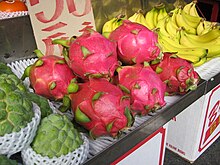

A pitaya (/pɪˈtaɪ.ə/) or pitahaya (/ˌpɪtəˈhaɪ.ə/) is the fruit of several cactus species indigenous to the region of southern Mexico and along the Pacific coasts of Guatemala, Costa Rica, and El Salvador.[1][2] Pitaya is cultivated in East Asia, South Asia, Southeast Asia, the United States, the Caribbean, Australia, Brazil, and throughout tropical and subtropical regions of the world.
Pitaya usually refers to fruit of the genus Stenocereus, while pitahaya or dragon fruit refers to fruit of the genus Selenicereus (formerly Hylocereus), both in the family Cactaceae.[3] The common name in English – dragon fruit – derives from the leather-like skin and scaly spikes on the fruit exterior. Depending on the variety, pitaya fruits may have sweet- or sour-tasting flesh that can be red, white, or yellow in color.
- ^ "Hylocereus undatus (dragon fruit)". Invasive Species Compendium. CABI (Centre for Agriculture and Bioscience International). 3 January 2018. Retrieved 19 April 2018.
- ^ Morton, J.F. (1987). Fruits of warm climates. West Lafayette, Indiana, USA: Center for New Crops & Plant Products, Department of Horticulture and Landscape Architecture, Purdue University. pp. 347–348. Archived from the original on 5 May 2016. Retrieved 8 April 2016.
- ^ Janick, Jules; Paull, Robert E., eds. (2008). "C". The Encyclopedia of Fruit and Nuts. Cambridge, United Kingdom: CABI (Centre for Agriculture and Bioscience International). pp. 215–216, 222–226. ISBN 978-0-85199-638-7.